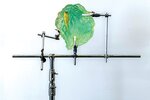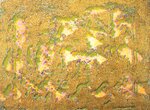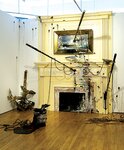Catskill Art Space is pleased to announce an exhibition of new work from Hovey Brock, Daniella Dooling and Valerie Hegarty. The exhibitions will be on view in the ground floor galleries of Catskill …
This item is available in full to subscribers.
Please log in to continue |



Catskill Art Space is pleased to announce an exhibition of new work from Hovey Brock, Daniella Dooling and Valerie Hegarty. The exhibitions will be on view in the ground floor galleries of Catskill Art Space, 48 Main Street, Livingston Manor, NY, from March 2 through April 27, 2024. Exhibition hours are Friday and Saturday, 11 a.m. – 5 p.m., and Sunday 11 a.m. – 3 p.m. On the show’s closing, April 27 at 4 p.m., the artists will participate in an Earth Day-inspired symposia on their practices and how they relate to the climate crisis. The three artists examine the destruction of environmental change, offering a foreboding warning to audiences. Amidst the devastation, the artists create a platform for dialogue between us to reduce that toll. From those shared experiences can come community, and ways of responding collectively to the climate crisis.
Hovey Brock’s Crazy River is a call for awareness of the environmental degradation the artist has witnessed in Frost Valley and the West Branch of the Neversink River in Ulster County, NY. Crazy River is about the loss, anger, fear, and disorientation Brock grapples within the growing wake of climate catastrophes. His installation of paintings on panels and “flags” made of plastic mesh and acrylic paint draped on wooden stands include phrases related to the climate crisis. Titles are taken in part from the obscured text on the paintings: What Do We Mean by Adaptation?, Invasive Species, and The Woods Are Stressed. The work is created by scraping layers of acrylic paint over the painted words and the mesh again and again, the process mirrors the artists own obsessive internal dialogue and frequent conversations with his peers over the topic of the climate crisis. The florid colors reflect the growing heat and turbulence in the environment, and the indecipherable words are reminiscent of the wake of invasive species and environmental ruin.
Daniella Dooling encases each bird in The Canary Project in resin casts of natural crystal formations or found rocks. A transparent facet reveals the embalmed bird, positioned upright and looking forward, a frozen gesture of isolation. The artificial fossilization of a canary inside a synthetic geological object held with medical hardware presents contradictory realities. The term “climate canary” has its origins in the phrase “canary in a coal mine.” These canaries are messengers, harbingers that a particular catastrophic event is near. The artist does not condone birds being bred in captivity and uses these birds in her work to honor their lives and reveal the problematic relationship between human beings and global animal extinction. The Canary Project is joined by Dooling’s newest body of work, FireNests, a détournement of abandoned, stolen and gifted bird nests. The bird nests are made from natural and human detritus, representing dynamics of survival, an incompatible compatibility. Dooling’s elegant constructions blackened with graphite, present a specter of past wildfires that have devastated the natural world, and us too.
Valerie Hegarty makes paintings, sculptures and installations that explore issues of memory, place and history. Hegarty replicates paintings and antiques from early American art history, then damages them with devices associated with their historical significance. Hegarty explores materiality through process, incorporating canvas, wood, Foam core, papier-mâché, epoxy and ceramics. The exhibition is centered around a large-scale installation, Overseas: Fireplace with Harpoons, which features a federal style fireplace modeled off one in the period rooms in The Metropolitan Museum of Art. The painting atop the mantle is of an iceberg by the Hudson River School painter, Frederic Church. The vignette is punctuated with destruction, harpoons piercing the scene, an allegory for the paintbrushes of landscape painters’ colonialist views of Manifest Destiny. The artist made the installation in 2006, offering a macropolitical view of the environmental crisis through the lens of colonialism.
Comments
No comments on this item Please log in to comment by clicking here